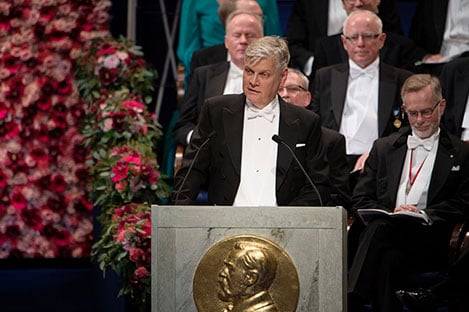Award ceremony speech
English
Swedish
Presentation Speech by Professor Nils-Göran Larsson, Member of the Nobel Assembly at Karolinska Institutet, Member of the Nobel Committee for Physiology or Medicine, 10 December 2016

Professor Nils-Göran Larsson delivering the presentation speech for the 2016 Nobel Prize in Physiology or Medicine at the Stockholm Concert Hall.
Copyright © Nobel Media AB 2016
Photo: Pi Frisk
Today we have gathered for the awarding of this year’s Nobel Prizes in the Stockholm Concert Hall, one of Sweden’s architectural masterpieces, which was inaugurated in 1926. The concert hall is in good shape despite intensive use over many decades, thanks to repairs and maintenance. Today it is also newly cleaned and spotless. The consumables that previous guests have left behind have been collected and hopefully recycled. We view this daily maintenance as something self-evident, but if the concert hall had not been repaired or cleaned in 90 years this would of course have been obvious to us. Similarly, our body’s cells are constantly replacing defective components and removing waste materials. This year’s Nobel Prize in Physiology or Medicine is about how the cell maintains its interior and recycles its own components in order to function optimally and adapt to new circumstances.
The cell’s degradation station, the lysosome, was identified by biochemical methods as early as 1955 by the Belgian scientist Christian de Duve. For this discovery, he was awarded the Nobel Prize in Physiology or Medicine in 1974. Shortly after the discovery of the lysosome, several researchers – using electron microscopy – showed that lysosomes seemed to exist in all organisms having nucleated cells. They also observed that lysosomes could sometimes be full of normal cellular components in various stages of decomposition. Remarkably, it appeared as if the cell could break down some of its own contents. In 1963 Christian de Duve named this process autophagy, which means self-eating. In the following decades, some progress was made in our understanding of autophagy, but fundamental questions remained unanswered: Is autophagy crucial to normal cell function? If so, how is autophagy regulated? Is autophagy important in human disease?
When Yoshinori Ohsumi was in his early 40s, he was eager to make new major scientific advances. In the late 1980s he therefore decided to take on a whole new area of research: cell degradation processes. Ohsumi predicted that degradation might very well be a process just as important as the production of new components in a cell. For his studies, he chose to use ordinary baker’s yeast. Yeast cells are unicellular eukaryotes, nucleated organisms that can be used as model systems for understanding fundamental processes also found in human cells. By employing a brilliant experimental strategy, Ohsumi was able to show that autophagy actually does occur in yeast. He then carried out a series of very elegant studies that enabled him to identify a number of genes that are vital in regulating autophagy. Ohsumi went on to show new, completely unexpected biochemical mechanisms that are controlled by these genes. It also soon turned out that the cellular machinery that controls autophagy is highly conserved and is found in all organisms containing nucleated cells.
The discovery of the molecular machinery of autophagy revolutionised Ohsumi’s entire field of research, and we know today that autophagy is a very important maintenance process that ensures the normal functioning of our cells. For example, autophagy plays a key role when we adjust our metabolism to fasting and starvation. Impairments in the regulation of autophagy are linked to a variety of human diseases, such as diabetes, cancer, infections and severe disorders of the nervous system. Thanks to Ohsumi’s fundamental discoveries, we now know that autophagy plays a fundamental role in many different biological processes.
Professor Ohsumi,
Your groundbreaking research has solved a long-standing enigma in biology and revealed mechanisms for how our cells recycle components and combat disease. With a series of brilliant experiments you have opened up a new field in biology. On behalf of the Nobel Assembly at the Karolinska Institute, it is my great privilege to convey to you our warmest congratulations. I now ask you to step forward to receive your Nobel Prize from the hands of His Majesty the King.
Nobel Prizes and laureates
Six prizes were awarded for achievements that have conferred the greatest benefit to humankind. The 12 laureates' work and discoveries range from proteins' structures and machine learning to fighting for a world free of nuclear weapons.
See them all presented here.
